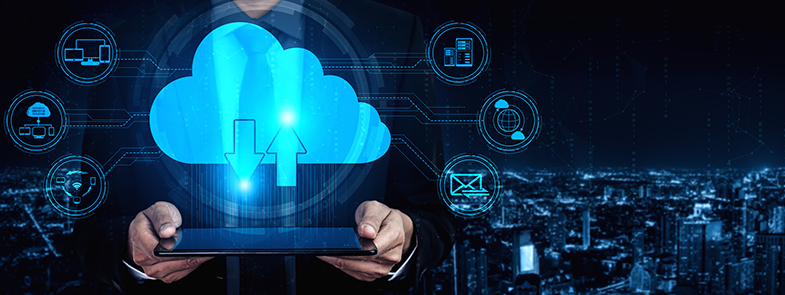Large organizations are by no means the only enterprises that could benefit from migrating to a cloud environment. Here’s how smaller organizations can get started.
Large enterprises incorporating a cloud environment into their operations usually have enough resources to employ consultants to ensure the hundreds of items on a migration to-do list aren't forgotten. Smaller entities tackling this task may benefit from an overview of first steps they can take on their own.
They can begin by considering a few basic strategic decisions.
One of the worst things that can happen is that an organization migrates to the cloud piecemeal because someone high on the totem pole suddenly decrees it. Urgency becomes the driving motivator, and people necessarily assume existing IT infrastructure and business practices will somehow stretch to cover the migration. This major error nearly always results in loss of efficiency, organization, and potential cloud-adoption benefits; at worst, it turns into a catastrophe looking for a scapegoat.
Enterprises that migrate without a comprehensive plan suffer. A Microsoft cloud governance guide offers a rule of thumb that there’s a dividing line at about 1,000 elements (adding together infrastructure, apps, and data sources), beyond which a cloud migration should rely on outside help and plan for at least a two-year implementation plan. For enterprises under that limit, formulating a DIY preliminary plan without outside consultants may be enlightening.
Cloud Governance Relies on Corporate Objectives
The first step in formulating any governance plan requires deciding on the business growth objectives that the organization wants to meet by moving to a cloud environment. This leads to the task of building a strategy for using cloud computing, which itself requires understanding growth opportunities, recognizing how a cloud environment can contribute to taking advantage of those opportunities, and deciding what Key Performance Indicators (KPIs) will inform the success of the migration over time.
Even if the organization doesn't currently use such a structure, planners should conceptually classify enterprise departments or projects into cost centers as a way of deciding broader issues such as workloads, cost-sharing, and security. Even more than traditional IT operations, cloud computing works best with a request system under which end users must formally ask for services and follow an established procedure for obtaining them. This helps IT departments (or whatever cloud governance structures are eventually set in place) maintain control budgets, computing resources, compliance requirements, and other administrative necessities.
A formal request structure also helps a governance team define asset and use policies for the entire enterprise rather than relying on ad hoc or separate group-based controls. This helps avoid unexpected costs related to manual or makeshift ways of tracking resources and user actions that threaten security or otherwise don't comply with organizational rules.
Cloud governance breaks down into four general areas, which consist of cloud financial management, cloud operations management, cloud data management, and cloud security and compliance management.
The financial aspect covers controlling both initial and ongoing costs of maintaining a cloud environment.
Operations management focuses on the nature of the service-level agreements (SLAs) that will define cloud system performance quality, specific cloud resource allocations, access controls, which users will be able to access what aspects of the overall system, and the processes governing conditions under which application code is added to the system.
Data management controls an enterprise's entire data lifecycle in a cloud environment. Perhaps foremost in this area is creating a data classification structure, which organizes data by type and sensitivity, and determines whether the data is affected by government regulations and how the data is encrypted at rest and in transit. The process also involves developing a strategy for deciding when data will be moved from high-access retrieval to lower-cost archival storage systems and how automated that process should be.
Security and compliance management involves not only the obvious concerns about keeping systems access and data secure, but also requires consideration of such issues as enforcing compliance requirements, assessing risk, planning for disaster recovery, and managing data use by authorized apps and systems. Also important in this area are how security and data/system use rules will be formulated, communicated to users, and generally enforced. Although hopefully there are already some policies existing in this realm even before considering a cloud environment, a formal statement of use and enforcement policies may be lacking and will need to be documented. This may require some changes to an organization's culture as well, particularly if these policies are currently informal.
Cloud Governance Principles
The Open Group, a global consortium of 840 organizations (evolved from the Open Software Group) that seeks to develop “vendor-neutral technology standards and certifications,” has formulated five cloud governance principles, which it recommends for use across a cloud lifecycle. Any enterprise considering cloud migration should be aware of each principle's ramifications, which are simplified below.
The first principle is that "cloud standards should be open, consistent with, and complementary to standards prevalent in the industry and adopted by the enterprise." In other words, by adopting common cloud governance standards, an enterprise can maintain interoperability of its systems and applications with those used by other organizations, as well as remain mindful of important risks (e.g., security, privacy, continuity) and clarify enforcement of important principles across its own user base.
The second is "cloud strategy should be an integral part of the overall business," meaning the mission of moving to cloud computing needs to be an element serving organic business needs rather than relying on the simple justification of "everyone else is doing it."
The third principle is "a clear set of rules and agreements [should] define the interaction between stakeholders," meaning that all users of a cloud ecosystem need to understand and adhere to cloud governance principles laid out by their organizations.
The fourth is that "change should be exercised and enforced in a consistent and standardized manner across [all constituents] of an enterprise cloud ecosystem," primarily referring to a need for existence and enforcement of a change management process in any cloud-using organization.
The fifth is that "cloud computing governance processes must dynamically events that trigger continuous improvements," which emphasizes that not only must cloud governance processes be continually monitored for the purposes of enforcement, but they also need to be watched for opportunities to make them better.
The underlying point is that governance requires rules and a framework that both executives and end users must follow if cloud migration is to have the desired effects. Failure to do so is one of the most common reasons migration projects either fail to live up to their potential or fail outright.
Another early decision an enterprise must make is how much control its own IT department will have in a cloud environment. There are two generalized cloud governance models, originally credited to the Gartner Group, one termed "in the way" governance and the other "on the side" governance.
"In the way" governance is like traditional IT practices. If data consumers, for example, want a change to how they can access and use data, they must submit a request to the IT department that works its way through the enterprise hierarchy until an executive at some level, after consulting existing cloud policies and the budget, decides whether it will be implemented. If approved, a request will be submitted to the cloud provider, which will then act on it at some unknown time. The IT department thereby acts as an initial gatekeeper, perhaps performing user provisioning tasks itself, but in general forcing centralized control that gives end users little autonomy and puts user requests at the mercy of executive political priorities and fulfillment scheduling difficulties due to possibly understaffed IT.
The "on the side" governance model lets cloud users access native cloud interfaces that have already been structured to conform to governance policies. Rather than acting in a time-consuming, rule-verification role, IT in effect automates this step and gives end users more autonomy and faster service. Here again, enterprise cultural issues may surface, particularly in smaller shops where one or two decision-makers are used to having veto power over user requests. However, an "on the side" structure moves from being preferred to becoming required as the complexity of business operations and cloud services necessary to support them increases.
Cloud Governance Standards
A final early decision an enterprise will have to make in the cloud governance arena is which of several cloud-governance standards it wants to follow. These are briefly outlined below.
Control Objectives for Information and Related Technologies (COBIT) is a standard formulated by ISACA (formerly known as the Information Systems Audit and Control Association). Its latest iteration appeared in 2019 and is characterized by having 40 management and governance objectives. Its focus is on implementation choices for technology, methods, and outsourcing. It has objectives that it categorizes into domains having to do with business processes (e.g., planning, monitoring, and creating), and it defines the connections between business goals and requirements. It's particularly useful for businesses concerned with adhering to Sarbanes-Oxley (SOX) financial requirements. COBIT is also known as a generic framework that conforms with other standards, such as ITIL.
Information Technology Infrastructure Library (ITIL) puts a sharper focus on IT service and asset management, particularly in the planning of new initiatives. It originated in 1989, but the latest version (V4) was released in 2019. ITIL helps an organization develop a baseline from which it can evaluate further progress. ITIL advocates a holistic approach to improving organization processes and helps users refine end-to-end digital product and service delivery methods.
ISO/IEC 38500 is a methodology issued by the International Organization for Standardization (ISO) and the International Electrotechnical Commission (IEC) to provide a framework for understanding any organization's ethical and regulatory obligations for its use of IT. This standard promotes efficient use of IT in any organization by making that function a subset of overall governance. The standard provides methods for defining responsibilities, supporting IT operations and technology acquisitions, analyzing how users interact with systems and applications, and establishing a vocabulary for IT governance activities.
A Recommendation for More Research
Although it's manifestly impossible to cover all aspects of setting up a cloud governance framework in a short essay, the few aspects mentioned here are part of the necessary first steps to approaching the topic. Cloud migration is not like buying a new accounting application. The implications of cloud adoption can require not just altering some internal procedures and shuffling job responsibilities among a handful of employees; it can require making a fundamental reassessment of the enterprise’s needs and goals. The entire concept must be carefully considered and researched. However vague that overall goal may seem, though, moving to cloud obligates its advocates to understand that a deep-rooted shift in governance practices will be a requirement.























 More than ever, there is a demand for IT to deliver innovation. Your IBM i has been an essential part of your business operations for years. However, your organization may struggle to maintain the current system and implement new projects. The thousands of customers we've worked with and surveyed state that expectations regarding the digital footprint and vision of the company are not aligned with the current IT environment.
More than ever, there is a demand for IT to deliver innovation. Your IBM i has been an essential part of your business operations for years. However, your organization may struggle to maintain the current system and implement new projects. The thousands of customers we've worked with and surveyed state that expectations regarding the digital footprint and vision of the company are not aligned with the current IT environment. TRY the one package that solves all your document design and printing challenges on all your platforms. Produce bar code labels, electronic forms, ad hoc reports, and RFID tags – without programming! MarkMagic is the only document design and print solution that combines report writing, WYSIWYG label and forms design, and conditional printing in one integrated product. Make sure your data survives when catastrophe hits. Request your trial now! Request Now.
TRY the one package that solves all your document design and printing challenges on all your platforms. Produce bar code labels, electronic forms, ad hoc reports, and RFID tags – without programming! MarkMagic is the only document design and print solution that combines report writing, WYSIWYG label and forms design, and conditional printing in one integrated product. Make sure your data survives when catastrophe hits. Request your trial now! Request Now. Forms of ransomware has been around for over 30 years, and with more and more organizations suffering attacks each year, it continues to endure. What has made ransomware such a durable threat and what is the best way to combat it? In order to prevent ransomware, organizations must first understand how it works.
Forms of ransomware has been around for over 30 years, and with more and more organizations suffering attacks each year, it continues to endure. What has made ransomware such a durable threat and what is the best way to combat it? In order to prevent ransomware, organizations must first understand how it works. Disaster protection is vital to every business. Yet, it often consists of patched together procedures that are prone to error. From automatic backups to data encryption to media management, Robot automates the routine (yet often complex) tasks of iSeries backup and recovery, saving you time and money and making the process safer and more reliable. Automate your backups with the Robot Backup and Recovery Solution. Key features include:
Disaster protection is vital to every business. Yet, it often consists of patched together procedures that are prone to error. From automatic backups to data encryption to media management, Robot automates the routine (yet often complex) tasks of iSeries backup and recovery, saving you time and money and making the process safer and more reliable. Automate your backups with the Robot Backup and Recovery Solution. Key features include: Business users want new applications now. Market and regulatory pressures require faster application updates and delivery into production. Your IBM i developers may be approaching retirement, and you see no sure way to fill their positions with experienced developers. In addition, you may be caught between maintaining your existing applications and the uncertainty of moving to something new.
Business users want new applications now. Market and regulatory pressures require faster application updates and delivery into production. Your IBM i developers may be approaching retirement, and you see no sure way to fill their positions with experienced developers. In addition, you may be caught between maintaining your existing applications and the uncertainty of moving to something new. IT managers hoping to find new IBM i talent are discovering that the pool of experienced RPG programmers and operators or administrators with intimate knowledge of the operating system and the applications that run on it is small. This begs the question: How will you manage the platform that supports such a big part of your business? This guide offers strategies and software suggestions to help you plan IT staffing and resources and smooth the transition after your AS/400 talent retires. Read on to learn:
IT managers hoping to find new IBM i talent are discovering that the pool of experienced RPG programmers and operators or administrators with intimate knowledge of the operating system and the applications that run on it is small. This begs the question: How will you manage the platform that supports such a big part of your business? This guide offers strategies and software suggestions to help you plan IT staffing and resources and smooth the transition after your AS/400 talent retires. Read on to learn:
LATEST COMMENTS
MC Press Online